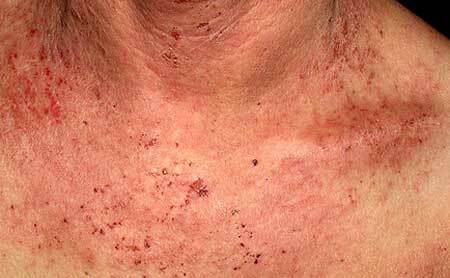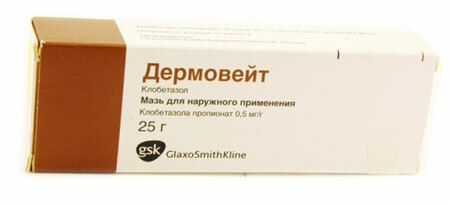New for most people the term "hyperhidrosis" means increased sweating. This condition is not an independent pathology and may indicate some malfunctioning of the body. An increased sweating according to different estimates suffers from 1-15% of the population.
Although hyperhidrosis does not pose a threat to health, its symptoms cause serious discomfort, especially when a person is in society or in intimate communication.
Contents of
- 1 Hyperhidrosis - what is it?
- 2 Symptoms of hyperhidrosis according to manifestation forms
- 3 Treatment of hyperhidrosis - drugs and recommendations for home
- 3.1 Hyperhidrosis: to which doctor should I apply?
Hyperhidrosis - what is it?
Hyperhidrosis is an increased sweating of the entire body or in certain areas of it( folds of the skin, face, palms and feet).Sweating is a normal function of the skin. However, with hyperhidrosis, under the influence of a provoking factor( excitement, stress, even minimal physical activity), the sweat glands begin to work in a strengthened mode. The person starts to sweat, there is a feeling of restraint from an unpleasant smell.

Sweating due to high air temperature, severe physical exertion and emotional reaction should not be considered as a deviation. However, some people are too vigorous to react to these factors, literally "soaking from head to toe."
Hyperfunction of sweat glands provoking physiological hyperhidrosis is caused by abnormal reaction of the sympathetic system.
About the causes of
Hyperhidrosis occurs most often in a localized form( palmar-plantar, large folds, face) and is triggered by one of the diseases:
- Endocrine disorders, including menopause in women, diabetes and obesity;
- Vegeto-vascular dystonia( hyperhidrosis with VSD most often occurs in adolescence and in emotionally unstable individuals);
- Flat-footed;
- Central nervous system disorders( Parkinson's disease, stroke) and brain trauma;
- Chronic lung diseases, including tuberculosis;
- A sharp drop in blood sugar levels.
Sometimes an additional cause of hyperhidrosis is genetic predisposition, insufficient body hygiene, wearing narrow or rubber shoes, synthetic clothing.
Symptoms of hyperhidrosis according to the forms of manifestation

In a person suffering from excessive sweating, there are quite unpleasant symptoms visible to the surrounding people.
Hyperhidrosis of armpits
Increased sweating of the armpits is the most common form of hyperhidrosis. The person is noticeable:
- Huge wet traces in the armpits;
- When dried, sweat leaves marks on clothing yellowish, red and purple;
- Pungent odor, visible to others even when using deodorant.
Hyperhidrosis of foot
The unpleasant odor from the feet that occurs quickly after washing is caused by a change in the acidity of the skin. At the same time on the "always wet from sweat" feet quickly develops fungus, which further exacerbates the external manifestations of hyperhidrosis.
Hyperhidrosis of the palms
Wet, always cold palms - in most cases a sign of unstable nervous system and high emotionality. Even a minimal experience can provoke immediate sweating of the palms. The person hesitates at handshake and dialogue with other people.
Hyperhidrosis of legs
In this case not only feet perspire, all skin of legs is covered with wet perspiration. Drops of sweat run down from the groin, causing rubbing on the inside of the thighs and irritating the tenderest skin of the popliteal pits.
Other signs of hyperhidrosis
Hyperhidrosis can also be localized to other areas of the skin. Somewhat less common is the common hyperhidrosis of the body. Thus appears:
- Redness and shine of the face, drops of perspiration on the forehead( a person constantly wipes his face with a napkin);
- Wear under the breast in women;
- Maceration of the skin in the groin;
- Flowing streams of sweat on the spine;
- Wet underwear - in such cases, the person says: "wet, at least squeeze."
Hyperhidrosis not only causes a decrease in self-esteem in a person and generates a mass of complexes. Skin areas of increased sweating are an excellent place for the reproduction of bacteria and fungi.
Therefore, people with hyperhidrosis often have pyogenic elements( acne), colorful lichen, streptoderma and other inflammatory skin diseases.
Treatment of hyperhidrosis - drugs and recommendations for home
Although diagnosing pathology is not difficult, but to identify the true cause is often quite difficult. But it is with a reason that it is necessary to start treatment of hyperhidrosis, so as to permanently rid the person of excessive sweating.
What can I do at home?

Treatment of hyperhidrosis at home
Simple rules will help a person significantly reduce the level of sweating. For this it is recommended:
- Refuse from eating hot, fatty, spicy food. Limit the use of salt. It is worth remembering: onions and garlic in dishes impart a particularly unpleasant smell to the sweat.
- Eliminate the use of alcohol, quit smoking.
- A frequent hygienic shower. The most suitable is a contrasting douche.
- Buy clothes only from their natural fabrics. Synthetics does not pass air and creates a "greenhouse" effect.
- Daily change of underwear, sock and pantyhose.
- Use of antibacterial insoles in shoes that prevent the reproduction of bacteria and fungus, as well as neutralize the unpleasant odor. Special insole can be replaced with daily soda pouring into shoes. The effect will be the same.
- Use of deodorants( only on a clean body!).A mixture of sweat and perfume gives no less a disgusting smell than the actual sweat. Common antiperspirants contain aluminum salts blocking the gland ducts, at a concentration of up to 3%.However, for a person with hyperhidrosis this is almost always not enough. In such cases, medical antiperspirants with increased salt concentration help. Such funds for hyperhidrosis of armpits are used only once a week and for greater effectiveness are applied overnight.
- Wiping abundantly sweating places( eg underarms) with soda solution. The use of baby powder will prevent skin maceration and the development of an inflammatory reaction - swelling and redness.
- Use of decoction of oak and alum - baths and wipes should be used regularly for a long time.
All the above procedures are only symptomatic treatment of hyperhidrosis. With the termination of their use, sweating again increases.
Medical procedures for the treatment of hyperhidrosis

Medical treatment of hyperhidrosis, drugs
Modern medicine has several methods to effectively eliminate excessive sweating. Such measures include:
- Application of Formidron, Formagel
These formaldehyde-containing products are effective only with a slight increase in sweating. They have antiseptic properties, which is especially important in the treatment of foot hyperhidrosis. The Teimurov paste also has a similar effect.
- Splitting of the hyperhidrosis zone by Botox,
Dispensed with botulotoxin, it is possible to quickly treat hyperhidrosis. During the procedure, the entire zone of excessive sweating is cut. Treatment with Botox is advisable only with localized hyperhidrosis.
At the same time, depending on the type of drug, the effect lasts only 6-12 months, after which the procedure should be repeated. Botox injections are performed in an outpatient setting, often in salons of qualified cosmetologists.
- Curettage of the problem area
Prior to the manipulation, the labeling of the iodine-starch breakdown of Minor is carried out. Then, under local anesthesia, a puncture of 5-10 mm( depending on the thickness of the skin) is made, through which a special curette the doctor exfoliates the skin.
At the same time small processes of the sympathetic nerve intersect and sweat glands are removed. The effectiveness of curettage - a decrease in sweating by 90% and complete elimination of a specific odor.
- Sympathectomy
The operation is performed endoscopically: all manipulations are performed through 2 punctures. With the help of a mini-camera, the doctor discovers a sympathetic nerve, which is placed on a special clip( clip) or crossed by a high-frequency current.
The operation requires general anesthesia, lasts no more than half an hour, and the patient is discharged from the clinic the next day.
It is possible to conduct sympathectomy as the main treatment for severe hyperhidrosis of the armpits, face. However, compensatory hyperhidrosis is not excluded: after the operation the body begins to sweat intensively on other sites.
Hyperhidrosis: to which doctor should I apply?

Hyperhidrosis is usually referred to a dermatologist or neurologist. However, often, to identify the cause of excessive sweating requires consultation of the endocrinologist, pulmonologist and other narrow-profile specialists.



